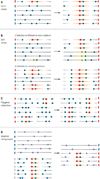Going global by adapting local: A review of recent human adaptation
- PMID: 27846491
- PMCID: PMC5154245
- DOI: 10.1126/science.aaf5098
Going global by adapting local: A review of recent human adaptation
Abstract
The spread of modern humans across the globe has led to genetic adaptations to diverse local environments. Recent developments in genomic technologies, statistical analyses, and expanded sampled populations have led to improved identification and fine-mapping of genetic variants associated with adaptations to regional living conditions and dietary practices. Ongoing efforts in sequencing genomes of indigenous populations, accompanied by the growing availability of "-omics" and ancient DNA data, promises a new era in our understanding of recent human evolution and the origins of variable traits and disease risks.
Copyright © 2016, American Association for the Advancement of Science.
Figures



References
-
- Enattah NS, et al. Nat. Genet. 2002;30:233–237. - PubMed
Publication types
MeSH terms
Grants and funding
LinkOut - more resources
Full Text Sources
Other Literature Sources

